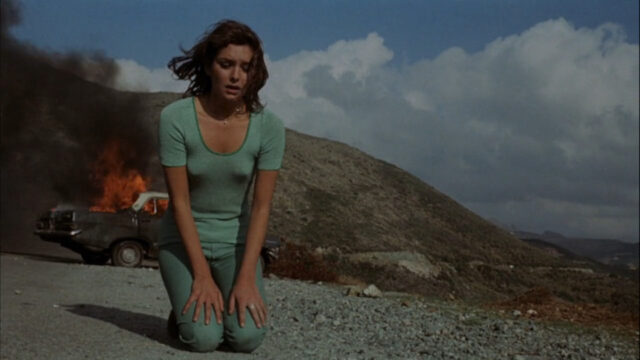
While Italian cinema had long been associated with neorealism and the lighthearted flair of classic Italian comedies, from the social satire of Commedia all’italiana to the charming chaos of Totò-giallo—it introduced a darker, more provocative cinematic language that shocked and captivated audiences in equal measure.
Italian giallo cinema emerged in the early 1960s as a distinctive blend of suspense, psychological tension, and stylized violence. Rooted in pulp literature and shaped by postwar cultural shifts, giallo films redefined genre boundaries and left a lasting impact on global horror and thriller movies.
It’s incredibly hard to put the history of a whole defining genre into a single article. But we will try to do it justice with our resume.
Origins: From Pulp Fiction to Cinematic Innovation
The term giallo, meaning “yellow” in Italian, originated from the yellow covers of crime novels, initially titled I libri gialli (“The Yellow Books”), which were published by Arnoldo Mondadori Editore in the 1930s. These books, often translations of British and American mysteries, became synonymous with suspenseful storytelling in Italy. As Italian filmmakers sought new narratives, they adapted the intrigue of these novels into a visual medium, giving rise to a new cinematic genre.
Mario Bava’s The Girl Who Knew Too Much (1963) is widely regarded as the first true giallo film. It introduced key elements such as a murder mystery plot, a vulnerable protagonist, and a series of red herrings leading to a climactic revelation. Bava’s subsequent film, Blood and Black Lace (1964), further developed the style with its use of vibrant colors, elaborate set pieces, and a focus on a masked killer targeting fashion models. Although not a commercial success at the time, its visual style and thematic content became templates for future films.
Defining Characteristics of Giallo Cinema
The giallo genre is known for its distinctive mix of crime fiction, psychological thriller, and stylized suspense. While diverse in plot and tone, giallo films consistently share certain cinematic and thematic traits that set them apart:
Stylized Depictions of Violence
One of the most recognizable features of giallo cinema is its highly staged murder scenes. These moments often involve a hidden or anonymous figure—typically seen only in close-up details like gloved hands or a shadowy outline—who executes each attack with precision and visual flair. The choreography of these scenes is central to the viewer’s experience, not just for tension but for visual design, often relying on sharp editing and unconventional angles.
Psychological Themes and Ambiguity
Giallo frequently explores fractured identities, mental instability, and interpersonal tension. Characters often wrestle with trauma, jealousy, or obsession, and the viewer is rarely sure who can be trusted. These psychological layers add complexity to the plot, while also reflecting deeper societal anxieties about identity and control.
A Striking Visual Language
Giallo films are visually distinctive. Directors use vivid color palettes—particularly saturated reds and yellows—as part of their storytelling. Lighting is intentionally exaggerated, often mixing deep shadows with sudden bursts of color. Camera work, too, is expressive: slow pans, subjective POV shots, and skewed compositions add to the sense of disorientation and suspense.
The Concealed Killer
Rather than introducing the antagonist early on, giallo narratives typically withhold the killer’s identity until the final scenes. The assailant is usually seen in disguise—face hidden, voice distorted, often clad in dark clothing. This anonymity sustains the mystery, encouraging the audience to interpret clues and question motives.
Twisting Narratives
Plots in giallo films are rarely linear. Many include misleading leads, abrupt shifts in perspective, and open-ended conclusions. The emphasis is on building curiosity and uncertainty rather than delivering tidy resolutions. Viewers are expected to stay engaged, reassessing characters and motives as new information is revealed.
Sound and Score as Narrative Tools
In giallo films often goes beyond the background atmosphere. It’s used to build unease, highlight emotional states, or cue pivotal moments. Composers such as Ennio Morricone and Goblin contributed scores that mixed traditional orchestration with electronic experimentation, reinforcing the unsettling tone that defines the genre.
These elements combined to create films that were as much about sensory experience as they were about storytelling.
Pioneers of the Giallo Genre
While Mario Bava is often credited with shaping the early cinematic language of giallo, it was Dario Argento who elevated the genre to a new level of international recognition. His 1970 debut, The Bird with the Crystal Plumage, introduced many of the elements that would become genre hallmarks: a foreign protagonist entangled in a murder mystery, stylized violence, and a killer whose identity remains elusive until the final act. The film was both a critical and commercial success, sparking a surge of similar productions in the early 1970s.
Argento’s Deep Red (1975) further cemented his reputation. With its layered narrative, elaborate set pieces, and a now-iconic score by the Italian band Goblin, the film pushed the genre toward more psychologically driven territory while retaining its visual flair. Argento’s work consistently blurred the line between horror and thriller, giving giallo a broader stylistic range and appealing to audiences beyond Italy.
Lucio Fulci, another major figure, introduced darker and more confrontational themes into the genre. His Don’t Torture a Duckling (1972) shifted the typical urban setting to a rural village, using the giallo format to examine superstition, religious hypocrisy, and class divides. Fulci’s later transition to supernatural horror continued to reflect giallo’s influence, particularly in his emphasis on shock and mood.
Sergio Martino brought a more overtly provocative angle to the genre. Films like The Strange Vice of Mrs. Wardh (1971) and All the Colors of the Dark (1972) showcased giallo’s capacity to blend psychological tension with erotic undertones. Martino’s films were also notable for recurring female leads—particularly Edwige Fenech—whose roles complicated the standard depiction of women in thriller narratives.
Umberto Lenzi, though sometimes overshadowed by his peers, also contributed significantly to the genre’s development. His film Paranoia (1969) and later Seven Blood-Stained Orchids (1972) experimented with structure and pacing, often incorporating espionage and political motifs.
These directors not only shaped the visual and thematic contours of giallo but also contributed to its longevity. Their distinct approaches allowed the genre to expand beyond formula, introducing elements from horror, noir, and even melodrama. Together, they created a body of work that remains influential in both genre cinema and arthouse circles to this day.
Cultural Impact and Legacy
Giallo films were not just entertainment; they reflected and influenced Italian society’s evolving attitudes towards sexuality, violence, and identity. The genre’s emphasis on style over substance challenged traditional storytelling, paving the way for future filmmakers to prioritize mood and atmosphere.
Internationally, giallo’s influence is evident in the slasher films of the 1980s, with directors like John Carpenter citing Argento as an inspiration. The aesthetic has also permeated music videos, fashion, and contemporary horror cinema.
Despite a decline in mainstream popularity, the style has experienced a resurgence in recent years. Filmmakers such as Peter Strickland and the duo Hélène Cattet and Bruno Forzani have drawn heavily from the visual language of the unique blend of horror and artistry. Restorations and re-releases of classic giallo films have introduced new audiences to the genre.
If you’re interested in exploring giallo films further, consider watching:
- The Girl Who Knew Too Much (1963) – Mario Bava
Nora Davis, an American tourist in Rome, witnesses a murder that mirrors a decade-old unsolved case. As she investigates, she becomes entangled in a series of killings, blurring the line between reality and paranoia. - Blood and Black Lace (1964) – Mario Bava
In a Roman fashion house, models are being murdered by a masked killer seeking a scandalous diary. The film is noted for its stylized violence and vivid color palette, setting a visual standard for the genre. - The Bird with the Crystal Plumage (1970) – Dario Argento
American writer Sam Dalmas witnesses an attempted murder in an art gallery and becomes obsessed with solving the case. His investigation uncovers a series of connected killings, drawing him deeper into danger. - Deep Red (1975) – Dario Argento
Musician Marcus Daly witnesses the murder of a psychic and partners with a journalist to find the killer. Their search leads to buried secrets and a series of gruesome discoveries. - Don’t Torture a Duckling (1972) – Lucio Fulci
In a rural Italian village, a string of child murders prompts a journalist and a local woman to investigate. Their inquiry exposes deep-seated superstitions and societal tensions. - The Strange Vice of Mrs. Wardh (1971) – Sergio Martino
Julie Wardh, the wife of a diplomat, is stalked by a mysterious killer while grappling with a past abusive relationship. As the body count rises, she suspects someone close to her may be responsible.
To Wrap Up
The rise of Italian giallo represents a fusion of literary tradition, visual innovation, and cultural expression. For cinephiles and indie filmmakers, giallo offers a rich tapestry of techniques and themes to explore. Its legacy endures, reminding us that sometimes, the most compelling stories are those that blur the lines between beauty and terror.
Disclaimer
The information contained in South Florida Reporter is for general information purposes only.
The South Florida Reporter assumes no responsibility for errors or omissions in the contents of the Service.
In no event shall the South Florida Reporter be liable for any special, direct, indirect, consequential, or incidental damages or any damages whatsoever, whether in an action of contract, negligence or other tort, arising out of or in connection with the use of the Service or the contents of the Service. The Company reserves the right to make additions, deletions, or modifications to the contents of the Service at any time without prior notice.
The Company does not warrant that the Service is free of viruses or other harmful components












